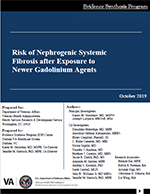
|
Prepared by: Recommended citation: |
Download PDF: Complete Report, Executive Summary, Report, Appendices
Nephrogenic systemic fibrosis (NSF) is a debilitating and, in most cases, fatal condition associated with exposure to certain gadolinium-based contrast agents (GBCA) administered during magnetic resonance imaging (MRI) or angiography (MRA) scans. Clinically, NSF presents as fibrosis of the skin and internal organs such as the heart, liver, and lungs, and occurs conspicuously in persons with end-stage renal disease (ESRD). The first reports of NSF occurred in the early 2000s, and recognition of a causative relationship between NSF and some GBCAs led to the issuance of an FDA boxed warning in 2007.
Gadolinium remains an optimal contrast agent for the enhancement of MRIs. Because gadolinium is toxic in its free form, it must be stabilized by chelation, or bonding, to a ligand to be safe for human use. GBCAs can be characterized by the structure of their individual chelate (macrocyclic/linear) and charge (ionic/non-ionic). These features contribute to the stability of a given GBCA and how easily gadolinium is disconnected from its ligand. These differences in stability of the linkage of gadolinium to the chelate ligand are thought to be a key factor in the risk of NSF as fibrosis development is thought to be due to gadolinium deposition in tissue. Newer GBCAs impart greater stability to the gadolinium-ligand bond and thus are thought to be associated with lower, or potentially minimal, NSF risk.
An additional critical risk factor for the development of NSF is renal impairment. All GBCAs are cleared, at least in part, from the body by the kidneys, and almost all cases of NSF have occurred in individuals with advanced kidney disease (eGFR <30 mL/min/1.73m2). However, other patient-level risk factors have been proposed as well, including the severity and chronicity of kidney dysfunction and inflammation.
While some advisory boards recommend liberalized use of the newer classes of GBCAs, others warn against risk for NSF with all classes of GBCAs. These divergent positions reflect uncertainties regarding the relative safety of newer versus older classes of GBCAs and the degree of kidney dysfunction that portends risk for NSF. In the VA, the use of gadolinium is currently restricted in Veterans with advanced kidney disease. These restrictions limit access to high-quality MRI for the diagnosis and management of numerous, and some life-threatening, diseases. Despite these uncertainties, few studies have assessed risk for NSF with GBCA exposure specifically in relation to newer agents; across the range of kidney function; and according to patients’ underlying profile on comorbid factors that might amplify NSF risk, including diabetes and hypertension. Thus, synthesizing the existing evidence about the safety profile of newer, and presumably more stable, GBCAs across the spectrum of kidney function could inform clinical policies.
The goal of this report is to provide a systematic review of the existing evidence on the risk of NSF with use of newer GBCAs, specifically American College of Radiology (ACR) group II and III agents, to inform the development of VA guidelines
KQ 1: When exposed to newer gadolinium-based contrast agents (defined as American College of Radiology group II and III agents), what is the occurrence of nephrogenic systemic fibrosis per index GBCA exposure among:
A. All patients without restriction by kidney function
B. Patients with key risk factors for chronic kidney disease (eg, diabetes and hypertension)
C. Patients with any degree of kidney disease (ie, acute kidney injury or chronic kidney disease)
KQ 2: When compared with older gadolinium-based contrast agents (American College of Radiology group I agents), what is the occurrence of nephrogenic systemic fibrosis per index GBCA exposure for newer GBCAs among:
A. All patients without restriction by kidney function
B. Patients with key risk factors for chronic kidney disease (eg, diabetes and hypertension)
C. Patients with any degree of kidney disease (ie, acute kidney injury or chronic kidney disease)
Risk of Nephrogenic Systemic Fibrosis after Exposure to Newer Gadolinium Agents (Management Brief)
Lunyera J, Mohottige D, Alexopoulos A, et al. Risk for Nephrogenic Systemic Fibrosis After Exposure to Newer Gadolinium Agents. Annals of Internal Medicine. Published online June 23, 2020. doi: https://doi.org/10.7326/M20-0299.